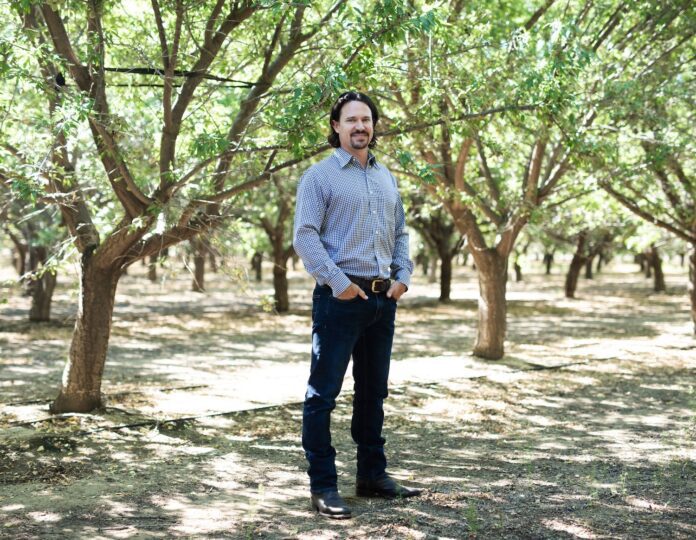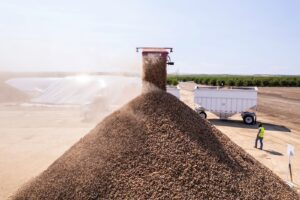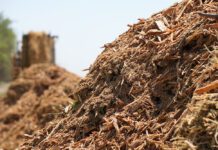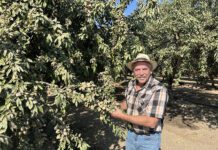
Blake Vann had only been on the board of the Almond Alliance of California for a year when his fellow directors elected him chairman last December.
Although Vann had never before served as chairman of an industry group, it was clear he brought deep-rooted experience and credibility to the table. The other directors understood that being new to the board didn’t mean new to the industry.
Vann is CEO of Vann Brothers, a family-owned, vertically integrated tree nut operation near Williams, a small town about 60 miles north of Sacramento. It’s a business woven into the life of this 42-year-old native Californian.
His father Garnett Vann and uncle, Bill Vann, planted their first almond trees in 1996 near Williams. They later built a processing facility and a huller-sheller. Their annual almond volume grew from 9 million pounds in the early days to 80 million today. The Vanns’ operation now handles almonds from 150 growers and counts 300 employees. There’s the growing and harvesting side of the business. From there, the almonds head to the family-owned Yolo Hulling and Shelling. Finally, they’re transported to Vann Family Orchards for processing and packaging for domestic and export markets. The family also grows walnuts, pistachios and some rice.
“I’m fortunate to see the whole spectrum, from the growing side to hulling and shelling to processing and marketing,” Vann said. “But we started as growers. That’s where our roots are.”

Moreover, Vann comes to Alliance’s chairmanship with a degree in international business from California State University, Sacramento. He also is a graduate of the California Ag Leadership Program as well as the Almond Board’s similar training program. He sits on the board of the Glenn-Colusa Irrigation District, the largest in the Sacramento Valley. And he’s also a member of the Colusa Groundwater Authority Board.
Now, Vann is rolling up his sleeves as he takes the helm of the Alliance’s complex world of almond policy, regulatory issues and trade barriers. In late January, he spoke with West Coast Nut about his goals for California’s almond industry.
Q. In your new role as chairman of the Almond Alliance of California, what are your priorities?
My priorities are to keep the Almond Alliance operating as efficiently as possible, focusing on the issues we can really make a difference in getting behind. One is the possibility of increased regulations coming down the pike in California, especially for plastics, pesticides and postharvest fumigation. Microplastics have become an increasing concern of consumers and our government. Plastic is involved in all types of food processing, and removing them will be difficult and costly. The industry is already going through multiple years of low prices. It’s a tough, tough time. So, it’s a really hard time for our industry to take on added regulations and the costs associated with them.

Q. What are your biggest concerns for the almond industry over the next year or two?
The low prices for growers are a major concern. People are choosing not to plant almonds. This is all supply and demand, so the market will correct itself and find balance eventually, although I would rather see our existing and emerging markets grow consumption than lose acreage. Almonds are an amazing food source that are very shelf-stable and packed with nutrition. We have a great story around sustainability and how good almonds are for the environment. An orchard is basically an agricultural forest. We sequester 30 million metric tons of carbon a year. That’s a story we need to tell versus the negative, false information that can be tossed about by others.
Q. Is building markets something the Almond Alliance does hand in hand with The Almond Board?
Yes, it’s a team effort. The Almond Board, being a marketing order, does the marketing and outreach on developing and protecting markets and consumption. The Almond Alliance has the ability to work with our representatives in government. We can keep tabs on regulations or even trade issues. We can work to enhance insurance options for farmers. The list goes on and on. We want to keep our family farmers farming.
Q. Talk about the trade barriers to overcome in the almond export market.
Our largest trade barrier would be the China tariffs. We are at a 25% disadvantage when selling into China. This gives Australia an advantage in that market and effectively lowers the overall price we can receive. India also has a tariff on almonds, and we would love to see that go away. Walnut tariffs were recently lowered, but the almond tariff remains. India does not have its own almond production so it would seem reasonable to get something done here.
Q. What solutions are needed to help California’s almond growers?
What we need to do is move product. We’ve been hitting shipment records month by month, and that’s exactly what we need. We need to finish out this marketing year with 500 million to 600 million pounds of carryout, and then the industry can start healthy next year. As long as we don’t have some mega bloom that’s going to produce a giant crop, then we should be getting back to prices where growers can survive. And then from there, between SGMA [Sustainable Groundwater Management Act] and the tree removals from how tough it’s been for the industry, I think the crop will end up balancing out, probably to around 2.6 billion pounds. It will swing up and down year to year, but once it settles at that level, it should be economical for growers. That will be great. We just need to survive the tough times and get those volumes out.
Q. At Vann Brothers, what will you do differently this year?
We will continue to focus on doing the best we can in every area. When my father and my uncle Bill started this company in 1972, they had no land. They leased 30 acres and grew dryland wheat. They built from that and just continued to grow and work hard. They always looked at every process to see if there was a different way to do it. There was never, “We do it this way because that’s the way we’ve always done it.” We don’t say that in this company. We analyze everything and ask the questions. We’ve grown a lot in the last six years. We’ve added facilities and employees. We’ve built ourselves to handle up to 100 million pounds or more. At this point, it’s just fine-tuning all of our processes and looking to see if there is anywhere we can be more efficient or effective. That is some of the most enjoyable work, finding ways to be better than yourself last year, every year.
Q. What would you like almond growers. processors and others in the industry to know?
Compared to other industries, dollar for dollar, almonds don’t have as large a political action committee. Successful industries need good advocacy to protect and sustain a healthy environment for them to operate in. One of my goals is to build our voice through a larger almond PAC here at the Almond Alliance. If we had a dollar for every acre of almonds in this state, we’d have quite a cache to help influence a lot of the issues coming down the pipeline. That would be extremely useful. The almond industry buys a lot of equipment and supplies to do business. We need our partners to join us in this mission as well.















